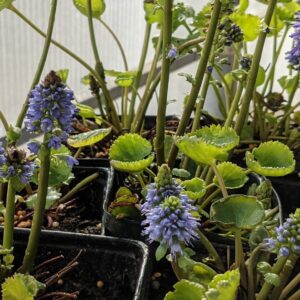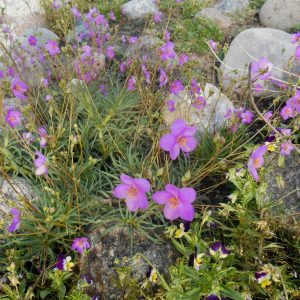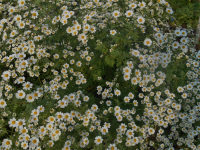Shop
Showing 713–720 of 788 results
-
Symphyandra zanzegura syn Campanula zanzegura Ring bellflower, Rock bellflower Z 5-10
Flared petal ends of lilac bells on wiry red stems over soft, velvety leaves bloom much of summer.
OUT OF STOCK
Flared petal ends of lilac bells on wiry red stems over soft, velvety leaves bloom much of summer.
Size: 15” x 15”
Care: full to part shade in well-drained soil
Native: mountains of Armenia, Eastern Europe
Wildlife Value: attracts beesDescribed and published by Ukrainian botanist Vladimir Lipsky (1863-1937) in 1894. Reclassified as a Campanula in 1980.
-
Syneilesis aconitifolia syn Senecio aconitifolius Shredded Umbrella Plant Z 3-8
Grown for its excellent foliage in dry shade. I guess “Shredded umbrella” best describes this plant with thin, dissected leaves atop a leafless stem. drooping in a rounded shape, like an umbrella, but it wouldn’t shelter from rain. Pale pink to white flowers in early to mid-summer.
OUT OF STOCK
Grown for its excellent foliage in dry shade. “Shredded umbrella” best describes this plant with thin, dissected leaves atop a leafless stem. Drooping in a rounded shape, like an umbrella, but it wouldn’t shelter from rain. Pale pink to white flowers in early to mid-summer.
Size: 3’ x 2’, spreads slowly by rhizomes
Care: part to full shade in moist, well-drained to well-drained soil. Drought tolerant once established.
Native: China, Korea & Japan and eastern Russia
Wildlife Value: Attracts bees, butterflies and birds. Deer and rabbit resistant.Described in Flora of China in 1833. Chinese used the whole plant for medicine, to relax and activate the tendons, alleviate pain around the waist and legs, and to treat most any injuries.
-
Synthyris missourica Mountain Kittentails Z 5-9
Spring flowering, true blue short stalks above leathery, evergreen leaves, circular with tooth margins.
ARCHIVED
Note: This is a plant not currently for sale. This is an archive page preserved for informational use.
Spring flowering, true blue short stalks above leathery, evergreen leaves, circular with tooth margins.
Size: 5-12” x 12” spreading into clumps by rhizomes.
Care: sun to part shade in moist to moist well-drained soil
Native: Mountains of northeast CA, Washington, Idaho & west to MontanaCollected by Meriwether Lewis on June 26, 1806 in today’s Idaho near the headwaters of what they named Hungry Creek. Common name kittentails imaginatively named for the flower stalk and its protruding stamens resembling, if you squint real hard and maybe after taking a swig of whiskey, fuzzy, blue kitten tails.
-
Syringa vulgaris Lilac, French lilac Z 4-8 SHRUB/SMALL TREE
Single or double, very fragrant lilac panicles in late spring
ARCHIVED
Note: This is a plant not currently for sale. This is an archive page preserved for informational use.
Single or double, very fragrant lilac panicles in late spring
Size: 20’ x 15’
Care: full sun in well-drained soil
Native: SE Europe, Caucasus to AfghanistanIntroduced to European from its native Turkey by Viennese ambassador De Busbecq (1522-1592). Grown in Jefferson’s garden at Monticello and Washington’s Mount Vernon. By 1850 “found in almost every (American) garden.” Breck (1851) ‘Alba’ listed in Tradescant the Elder’s 1634 list as “Lilac Matthioli.” Elias Ashmole’s manuscript, “trees found in Mrs. Tradescants ground when it came into my possession (1662) as ‘Syringa alba.’ ” Pressed specimen in Emily Dickinson’s herbarium.
-
Talinum calycinum syn. Phemeranthus calycinus Rock rose, Fameflower Z 6-9
Bright mauve flowers dance on wiry stems in afternoons all summer, closing at night. Leaves are succulent.
Tender reseeding perennial, but they survived the horrible winter of 2013-14. In any event they reseed reliably. Just watch for little succulent leaves.
Bright mauve flowers dance on wiry stems in afternoons all summer, closing at night. Leaves are succulent.
Size: 8-12” x 4”
Care: Sun in well-drained soil
Native: western Plains statesCollected by Dr. Frederick Wislizenus on sandy soil near the Cimarron River on an exploring trip of Texas, New Mexico and Mexico in 1846. Wislizenus (1810-1889) was a German immigrant, explorer, botanist, and medical partner of George Engelmann (1809-1884) important promoter of plant-hunting and expert on cacti and conifers.
-
Talinum paniculatum ‘Limon’ Jewels of Opar ANNUAL Succulent sub-shrub Z 9-11
Pink flowers bloom June-Nov. above lime green foliage followed by carmine seed pods that are more showy than the flowers.
Pink flowers bloom June-Nov. above lime green foliage followed by carmine seed pods that are more showy than the flowers.
Size: 18-24” x 18-24”
Care: sun in well-drained soil.
Native: Southern US, much of Latin America and the Caribbean.
Wildlife Value: attracts beesLeaves are edible as a salad green; seeds compared with flax seeds in nutritional value. According to homeopathy this used to treat headaches, aphrodisiacs, pneumonia, diarrhea, excess urine, irregular menstruation, vaginal discharge, impotence, ulcers and low appetite.
Collected before 1791
-
Tanacetum armenum syn. Leucanthemum armenum Snow daisy
Dwarf subshrub covered with mound of silvery foliage and little white daisies in June to July
ARCHIVED
Note: This is a plant not currently for sale. This is an archive page preserved for informational use.
Dwarf subshrub covered with mound of silvery foliage and little white daisies in June to July
Size: 5-6” x 8-10”
Care: sun in well-drained soil
Native: TurkeyCollected before 1844
-
Tanacetum niveum Silver tansy, Snow tansy Z 5-9
Profusion of small classic daisies May-July atop fragrant silver foliage. Cut back for rebloom. Let the seeds drop for more plants next year. If you cut them back after the 1st flowering they will rebloom for most of the summer and fall.
Profusion of small classic daisies May-July atop fragrant silver foliage. Cut back for rebloom. Let the seeds drop for more plants next year. If you cut them back after the 1st flowering they will rebloom for most of the summer and fall.
Size: 2’ x 3’
Care: sun in moist well drained soil
Native: central & southern EuropeNamed by Carl Heinrich Schultz (1805-1867)





